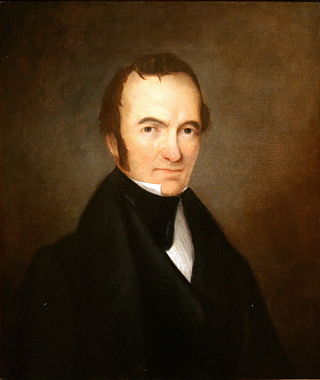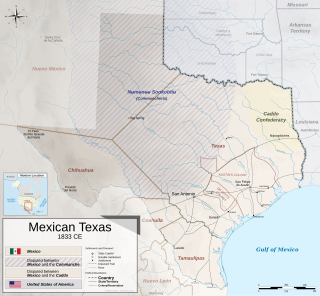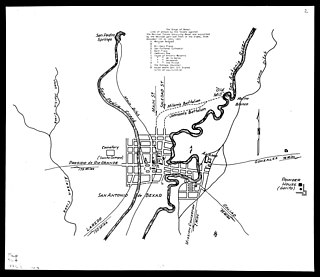
Stephen Fuller Austin was an American-born empresario. Known as the "Father of Texas" and the founder of Anglo Texas, he led the second and, ultimately, the successful colonization of the region by bringing 300 families and their slaves from the United States to the Tejas region of Mexico in 1825.

Bellville is a city in the U.S. state of Texas and the seat of Austin County. The city's population was 4,206 at the 2020 census. Bellville is on the eastern edge of the Texas-German belt, and Bellville is known for its German culture and descendants of those Germans still call Bellville home.

Mexican Texas is the historiographical name used to refer to the era of Texan history between 1821 and 1836, when it was part of Mexico. Mexico gained independence in 1821 after winning its war against Spain, which began in 1810. Initially, Mexican Texas operated similarly to Spanish Texas. Ratification of the 1824 Constitution of Mexico created a federal structure, and the province of Tejas was joined with the province of Coahuila to form the state of Coahuila y Tejas.
James Clinton Neill was an American soldier and politician, most noted for his role in the Texas Revolution and the early defense of the Alamo. He was born in North Carolina and served in the Alabama House of Representatives between 1825 and 1827.
The Consultation, also known as the Texian Government, served as the provisional government of Mexican Texas from October 1835 to March 1836 during the Texas Revolution. Tensions rose in Texas during early 1835 as throughout Mexico federalists began to oppose the increasingly centralist policies of the government. In the summer, Texians elected delegates to a political convention to be held in Gonzales in mid-October. Weeks before the convention and war began, the Texian Militia took up arms against Mexican soldiers at the Battle of Gonzales. The convention was postponed until November 1 after many of the delegates joined the newly organized volunteer Texian Army to initiate a siege of the Mexican garrison at San Antonio de Bexar. On November 3, a quorum was reached in San Antonio. Within days, the delegates passed a resolution to define why Texians were fighting. They expressed allegiance to the deposed Constitution of 1824 and maintained their right to form the General Council. In the next weeks, the council authorized the creation of a new regular army to be commanded by Sam Houston. As Houston worked to establish an army independent from the existing volunteer army, the council repeatedly interfered in military matters.

The siege of Béxar was an early campaign of the Texas Revolution in which a volunteer Texian army defeated Mexican forces at San Antonio de Béxar. Texians had become disillusioned with the Mexican government as President and General Antonio López de Santa Anna's tenure became increasingly dictatorial. In early October 1835, Texas settlers gathered in Gonzales to stop Mexican troops from reclaiming a small cannon. The resulting skirmish, known as the Battle of Gonzales, launched the Texas Revolution. Men continued to assemble in Gonzales and soon established the Texian Army. Despite a lack of military training, well-respected local leader General Stephen F. Austin was elected commander.

The "Old Three Hundred" were 297 grantees who purchased 307 parcels of land from Stephen Fuller Austin in Mexican Texas. Each grantee was head of a household, or, in some cases, a partnership of unmarried men. Austin was an American approved in 1822 by Mexico as an empresario for this effort, after the nation had gained independence from Spain. By 1825 the colony had a population of 1,790, including 443 enslaved African Americans. Because the Americans believed they needed enslaved workers, Austin negotiated with the Mexican government to gain approval, as the new nation was opposed to slavery. Mexico abolished it in 1837.
James Kerr was a doctor, politician, Senator in Missouri, soldier, surveyor and Congressman in Texas who was active in the establishment of the Republic of Texas.

The Varner–Hogg Plantation State Historic Site is a historical site operated by the Texas Historical Commission. The site was the home of former Governor of Texas James S. Hogg and his family. The site is located outside West Columbia, in Brazoria County.

Green DeWitt was an empresario in Mexican Texas. He brought families from the United States to what is now South-central Texas and founded the DeWitt Colony.
Philip Dimmitt (1801–1841) was an officer in the Texian Army during the Texas Revolution. Born in Kentucky, Dimmitt moved to Texas in 1823 and soon operated a series of trading posts. After learning that Mexican General Martín Perfecto de Cos was en route to Texas in 1835 to quell the unrest, Dimmitt proposed that the general be kidnapped on his arrival at Copano. The plan was shelved when fighting broke out at Gonzales, but by early October, 1835, it had been resuscitated by a group of volunteers at Matamoros. Not knowing that Cos had already departed for San Antonio de Bexar, this group decided to corner Cos at Presidio La Bahia in Goliad. Dimmitt joined them en route, and participated in the battle of Goliad.

Emily Austin Bryan Perry was the sister of Stephen F. Austin and an early settler of Texas. She was an heir to Austin's estate when he died in 1836. She achieved significant political, economic and social status as a woman in Texas at a time when women were often not treated equal to men.
James Franklin Perry (1790–1853) was an American who was an early settler and prominent citizen of Texas. James married to Emily Austin Perry, and together they operated Peach Point Plantation. He was involved in Texas land distribution.
Patricia de la Garza De León (1775–1849) was the matriarch of one of the prominent founding families of early Texas. Doña Patricia raised ten children, some of whom helped change the course of history. At age 49, she uprooted her life in 1824 to help her husband Martín De León establish the predominantly Mexican De León's Colony. She contributed her inherited assets to the founding of the colony, and helped establish a school and a church. From the onset, she worked to instill a sense of Mexican and Spanish culture in the colony. After the death of her husband, Doña Patricia assumed the role of head of the family. Recorded Texas Historic Landmark number 6539 placed at Evergreen Cemetery in 1972 acknowledges Patricia de la Garza De León's contribution to Texas. Recorded Texas Historic Landmark number 6543 placed at Church and Bridge Streets in 1936 denotes the home of Patricia de la Garza De León and Don Martin De León's home in Victoria.

Robertson's Colony was an empresario colonization effort during the Mexican Texas period. It is named after Sterling C. Robertson, but had previously been known by other names. It has also been referred to as the Nashville Colony, after the Tennessee city where the effort originated, the Texas Association, the Upper Colony, and Leftwich's Grant, named after early colonizer Robert Leftwich. The eventual contract spread over an area that includes all or part of thirty present-day counties in Texas.

Samuel May Williams was an American businessman, politician, and close associate of Stephen F. Austin, who was an Anglo-American colonizer of Mexican Texas. As a teenager, Williams started working in the family's mercantile business in Baltimore. He spent time in South America and New Orleans, fleeing the latter because of debts. He landed in Mexican Texas in 1822, having learned French and Spanish. Stephen F. Austin hired Williams for his colony in 1824. Williams first worked as a clerk, and later assumed the title of secretary to the ayuntamiento, a local government established for the colony by the Mexican state of Coahuila and Texas. He worked for Austin for about a decade.

The Lake Creek Settlement was a settlement in Stephen F. Austin's Second Colony, located in Mexican Texas, and later the Republic of Texas after it gained independence in 1836. The Lake Creek Settlement was located between the West Fork of the San Jacinto River (Texas) and the stream known as Lake Creek. It was the first Anglo-American settlement in what is today western Montgomery County, Texas.
Horatio Chriesman was an American surveyor, politician in Mexican Texas and participant in the Texas Revolution.

Thomas Freeman McKinney was a trader, merchant, and a co-founder of Galveston, Texas. Living with his family in the western states of Kentucky, Illinois, and Missouri, he started trading in Mexico in 1823. The next year he settled in Stephen F. Austin's Colony, claiming a headright to Texas land while continuing his trading activities. He established a partnership with Samuel May Williams in 1834, and they operated a warehouse at the mouth of the Brazos River. The McKinney & Williams partnership loaned money and vessels to the cause of Texas independence. After Texas gained independence from Mexico, McKinney co-founded Galveston, Texas, and the McKinney & Williams company set up a warehouse and dock in the new town. McKinney later sold his share of the McKinney & Williams partnership and retired to Travis County, Texas.

Jose Miguel de Arciniega (1793–1849) was a Mexican military explorer and legislator. He was mayor of San Antonio, Texas, in 1830 and 1833.












